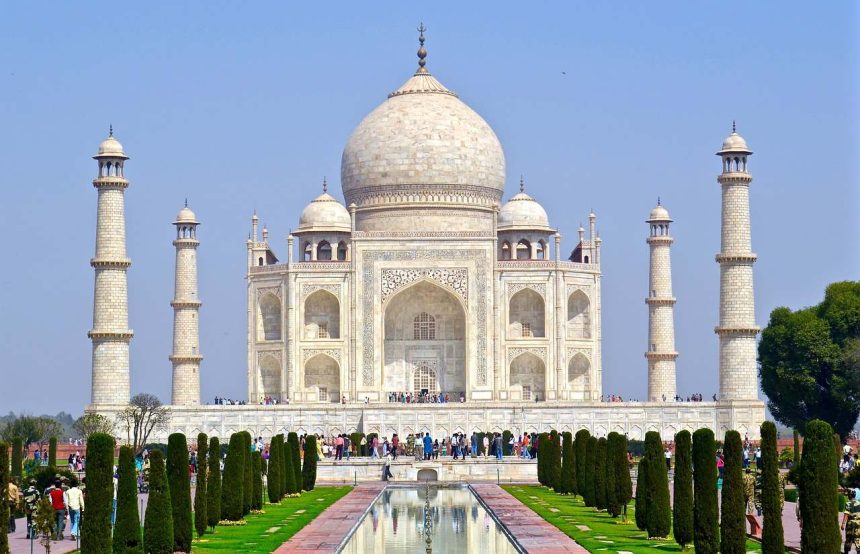The United Nations Educational, Scientific and Cultural Organization (UNESCO) recognizes certain sites worldwide for their exceptional cultural or natural significance. These World Heritage Sites symbolize a nation’s history and heritage, representing its cultural and natural beauty. In India, there are currently 43 UNESCO World Heritage Sites, each holding great importance. Of these, 35 are cultural, seven are natural, and one—Khangchendzonga National Park—is recognized as a mixed heritage site. These landmarks are a source of immense pride for the nation, showcasing its rich legacy to the world. In this article, we explore the first UNESCO World Heritage Sites in India and their significance.
The First UNESCO World Heritage Sites in India
India’s journey with UNESCO began in 1983 when four iconic monuments were inscribed as World Heritage Sites. These first entries were the Taj Mahal, Ajanta Caves, Ellora Caves, and Agra Fort. Each of these sites stands as a testament to India’s rich history, cultural diversity, and architectural brilliance.
Taj Mahal: The Jewel of Islamic Art in India
Arguably the most famous UNESCO Heritage Site in India, the Taj Mahal is an ivory-white marble mausoleum located on the right bank of the river Yamuna in Agra, Uttar Pradesh. Built in 1631 by the Mughal Emperor Shah Jahan, this breathtaking monument was constructed to house the tomb of his beloved queen Mumtaz Mahal. The grandeur of the Taj Mahal doesn’t stop there; it also contains Shah Jahan’s tomb, positioned at the heart of the complex, surrounded by formal gardens, a mosque, and a guest house. UNESCO describes it as “the jewel of Islamic art in India and one of the universally admired masterpieces of world heritage.”
Agra Fort: A Stronghold of Mughal History
The Agra Fort is another masterpiece of Mughal architecture, deeply tied to the rise of the Mughal Empire. The fort became the seat of power for the empire when Babur, the first Mughal emperor, took residence here after invading India. In 1530, his son Humayun was crowned at the Agra Fort, marking a significant moment in Indian history. Akbar, the third Mughal ruler, renovated the fort from 1565 to 1573, transforming it into a formidable stronghold. Until 1638, the fort remained the principal residence of Mughal emperors before Shah Jahan shifted the capital to Delhi. The fort’s historical significance and architectural marvels earned it UNESCO World Heritage status.
Ajanta Caves: Masterpieces of Buddhist Art
The Ajanta Caves are a collection of 30 rock-cut Buddhist cave monuments located in Maharashtra, dating back to the 2nd century BCE to around 480 CE. These caves are celebrated for their remarkable paintings and rock-cut sculptures, which are considered masterpieces of ancient Indian art. The Ajanta Caves reflect the rich tradition of Buddhist religious art, with detailed frescoes and expressive murals that have stood the test of time. Their significance in preserving ancient Indian and Buddhist history led to their recognition as a World Heritage Site.
Ellora Caves: An Architectural Wonder
Another marvel of rock-cut architecture, the Ellora Caves, also situated in Maharashtra, is one of the largest temple cave complexes in the world. The Ellora Caves, dating from 600–1000 CE, showcase a unique blend of Hindu, Buddhist, and Jain traditions, illustrating the harmonious coexistence of these faiths in ancient India. The most famous among the caves is Cave 16, which houses the Kailash Temple, the largest single monolithic rock excavation in the world. This awe-inspiring structure is dedicated to Lord Shiva and is shaped like a chariot. The caves also feature intricate sculptures of Hindu deities and panels depicting scenes from the great Hindu epics, the Ramayana and Mahabharata.
India’s UNESCO World Heritage Sites are a testament to the country’s rich cultural heritage and historical significance. From the iconic Taj Mahal to the artistic grandeur of the Ajanta and Ellora Caves, these sites continue to attract visitors from across the globe, serving as timeless reminders of India’s glorious past. The inclusion of these sites on UNESCO’s list is not only a matter of pride but also a responsibility to preserve and protect them for future generations.




